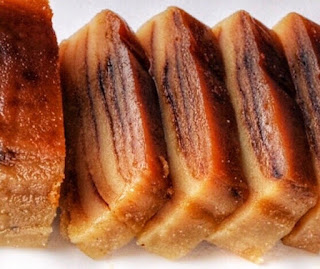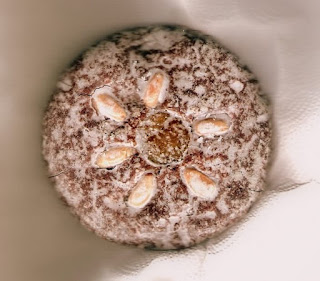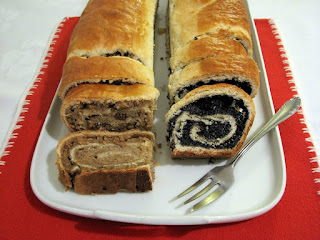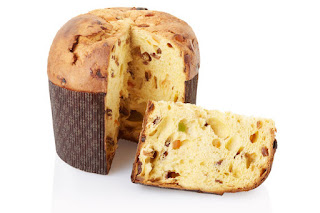 |
| Spanish dessert, Roscón de Reyes |
Bebinka
Bebinka is a multilayered dessert prepared out of coconut milk , sugar and egg yolks at Christmas in Goa, a former Portuguese colony, but now a state in western India, known for its beaches and a unique mix of Indian and Portuguese cultures and architecture. |
| Bebinka |
Making a bebinka is a long and slow process as each layer is added when the one below it has turned golden and puffed, but not too dark. The number of bebinka layers typically vary between 7 to 16, depending upon the time a family is willing to invest in its preparation. The ingredients include plain flour, sugar, nutmeg, egg yolk, coconut milk and ghee (clarified butter) which holds the layers together.
Bebinka is served as a dessert and as a late afternoon snack on Christmas day.
Christmas Pudding
Christmas pudding also known as plum pudding is traditionally served as part of the Christmas dinner in the United Kingdom, Ireland and in other countries like Australia, Canada, New Zealand and South Africa where it has been brought by British emigrants.The pudding has its origins in medieval England and many households have their own recipe for Christmas pudding, some handed down through families for generations.
 |
| Christmas pudding by Matt Riggott |
Despite the name 'plum pudding', the pudding contains no actual plums due to the pre-Victorian use of the word 'plums' as a term for raisins. The Victorians shaped their puddings into a spherical shape and boiled them in a muslin cloth.
Stir-up Sunday is a centuries-old annual tradition where home cooks spend the last Sunday before Advent preparing their Christmas pudding, in order to allow it at least a month to mature before being served on Christmas Day. Traditionally everyone in the household, or at least every child, gives the mixture a stir and makes a wish during its preparation.
It is also an old tradition and a sign of prosperity in the coming year to include small silver coins in the pudding mixture, which could be kept by the person whose serving included them.
At Christmas, when the pudding is ready to be served, it is traditionally doused in brandy and set alight, before it is ceremoniously brought to the table and greeted with a round of applause.
Gingerbread Cookies
The sweet-and-spicy gingerbread cookies are a popular Christmas baking tradition in many different parts of the world. Gingerbread cookies are traditionally made of dough, a sweetener such as honey, sugar or molasses and spices such as ginger, cloves and cardamom then cut and baked into the appropriate shapes. |
| Gingerbread cookies |
The tradition of creating gingerbread houses, was inspired by the publishing of Hansel and Gretel, a fairy tale of German origin by the Brothers Grimm in 1812.
 |
| Lebkuchen from Nuremberg with almonds |
Gingerbread cookies are one of the most iconic Christmas treats and its preparation is a wonderful and deep-rooted family tradition that involves the young and the old in numerous countries around the world.
Mince Pie
A mince pie is a sweet pie of British origin, filled with a mixture of dried fruits and spices that is traditionally served during the Christmas season in the United Kingdom. |
| Mince pie |
Early pies were oblong shaped and much larger than those consumed today. Over a period of time, besides becoming smaller, the recipe also became sweeter.
On Christmas Eve, children in the UK often leave out mince pies for Santa, and a carrot for the reindeer.
Nut Roll
Nut roll is a pastry made of a sweet yeast dough, rolled out very thin, traditionally filled with ground walnuts or poppy seeds and a sweetener like honey, then rolled up into a log shape. Nut rolls are a popular dessert at Christmas in many Central European countries and also in the United States. |
| Beigli, walnut (left) and poppy seed (right) by Hu Totya |
Nut roll is made by rolling flat a sweet yeast dough and then spreading the filling of ground poppy seeds or walnuts on it. The filled dough is rolled up, in the shape of a log and then baked.
Nut rolls are an essential part of Christmas celebrations in many Central European countries and also in the United States where they were introduced by Central European immigrants and widely adopted by other ethnic groups in the region.
Panettone
Panettone is an Italian sweet dome-shaped bread loaf made of flour, yeast, candied fruits and raisins, usually prepared and enjoyed for Christmas and New Year.Though the origin of Panettone is attributed to the Italian city of Milan in the Middle Ages, the tradition of making this sweet bread during the Christmas season can also be found in other parts of Europe and South America. The basic origins of the dessert go back to the Roman Empire, when ancient Romans sweetened a type of leavened cake with honey.
 |
| Panettone |
The word 'panettone' derives from the Italian word 'panetto', a small loaf cake. The augmentative Italian suffix "'-one' changes the meaning to 'large cake'.
Panettone is typically served with sweet hot beverages or a sweet wine, such as Moscato d'Asti. In Italy, it is traditionally served after the Christmas meal or on the feast of Santo Stefano, celebrated on December 26th, besides on New Year’s Eve and New Year’s Day.
This sweet bread can also be found in South and North American countries due to the Italian immigrants, and it is typically served during the holiday season or on Christmas with hot cocoa or liquor.
Pavlova
Pavlova is a meringue-based dessert with a crisp crust, layered with whipped cream and fresh fruit that is served at Christmas in Australia and New Zealand.This dessert which is also very popular during the summer is believed to have been created in honor of Russian ballerina Anna Pavlovna either during or after one of her tours to Australia and New Zealand in the 1920s. Anna Pavlova was considered the greatest ballerina of her time.
 |
| Pavlova dessert by Hazel Fowler |
Pavlova which is made by beating egg whites before folding in caster sugar, cornstarch and vinegar and then slow-baking the mixture, similar to meringue. The ingredients and its preparation gives it a crisp and crunchy outer shell, and a soft, moist marshmallow-like center.
Pavlova is traditionally decorated with a topping of whipped cream and fresh fruit such as kiwifruit, passionfruit, raspberries and strawberries. It is usually refrigerated before serving due to Christmas being celebrated during the summer in the southern hemisphere.
Pavlova is served on Christmas day in Australia and New Zealand.
Rabanada
Rabanada is a French Toast which usually makes an appearance on the Brazilian breakfast table around Christmas.Rabanada is made with diagonal slices of French bread soaked in a mixture of milk, sugar and eggs, deep fried and then sprinkled with sugar and cinnamon. The result is a delicious French toast that is creamy and custardy on the inside and crispy on the outside.
 |
| Rabanada |
In Brazil, Rabanada is typically served at breakfast, as a dessert or a late afternoon snack with coffee during the Christmas season.
Turrón
Turrón is a candy made of almonds and honey traditionally served at Christmas in Spain as well as in several former Spanish colonies, particularly in Latin America.Turrón has been made at least since the 15th century in the town of Xixona (Valencian) or Jijona in Valencia on the eastern coast of Spain, which is known for its extensive almond farming that has existed since the Moorish farmers originally cultivated the almond trees following the Islamic conquest of the Iberian peninsula.
 |
| Turrón de Alicante by Tamorlan |
In Italy, this sweet confection is known as torrone and is traditionally served in some parts of Italy, particularly in Abruzzo, Campania, Lombardy, Sicily and Sardinia at Christmas time.
The Spanish turrón may be classified as Turrón de Alicante which is hard containing whole almonds and Turrón de Jijona which is soft with the almonds reduced to a paste.
Yule Log
A Yule log is a traditional dessert served at Christmas especially in Belgium, Canada, France and several former French colonies. It refers to the log burned on a fireplace as a Christmas tradition in a number of countries in Europe, going far back as the 12 century. |
| Yule log by Jebulon |
In France, the Yule log dessert is called 'bûche de Noël' which literally translates as 'Christmas log', referring to the traditional Yule log burned centuries past.
Yule log cake is often served with one end cut off and set atop the cake, or protruding from its side to resemble a chopped off branch. It may be served at any time during the Christmas season, but traditionally served at the Christmas celebration that follows Mass on Christmas Eve.
Recommended Reading
The History and Tradition of GingerbreadArticle Category: Food & Culture




No comments